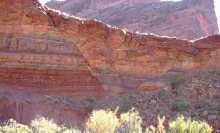Article
Geologic faults form along the edges of tectonic plates, which are planar fractures in the earth’s crust, as the plates become compressed or filled with tension as they are forced together. When faults move, they can form valleys and mountains. In addition, as faults react to the forces that the huge tectonic plates exert against each other, fissures perpendicular to the earth's surface can extend deep below ground to reserves of molten rock, which, if they reach the surface, form volcanos. When the energy of plates under compression is released as the plates grind against each other, it can also cause earthquakes. There are many faults in the American Southwest, both active and inactive, including the Rio Grande Rift in New Mexico.
"Example of a normal fault in Upheaval Dome caused by extension in the rocks near San Juan, Utah, October 14, 2005" by Jesse Varner is licensed under CC BY-NC-SA.
Manuscripts
References
Encyclopædia Britannica Online
N.d. Fault. http://www.britannica.com/EBchecked/topic/202708/fault, accessed
December 04, 2014.

